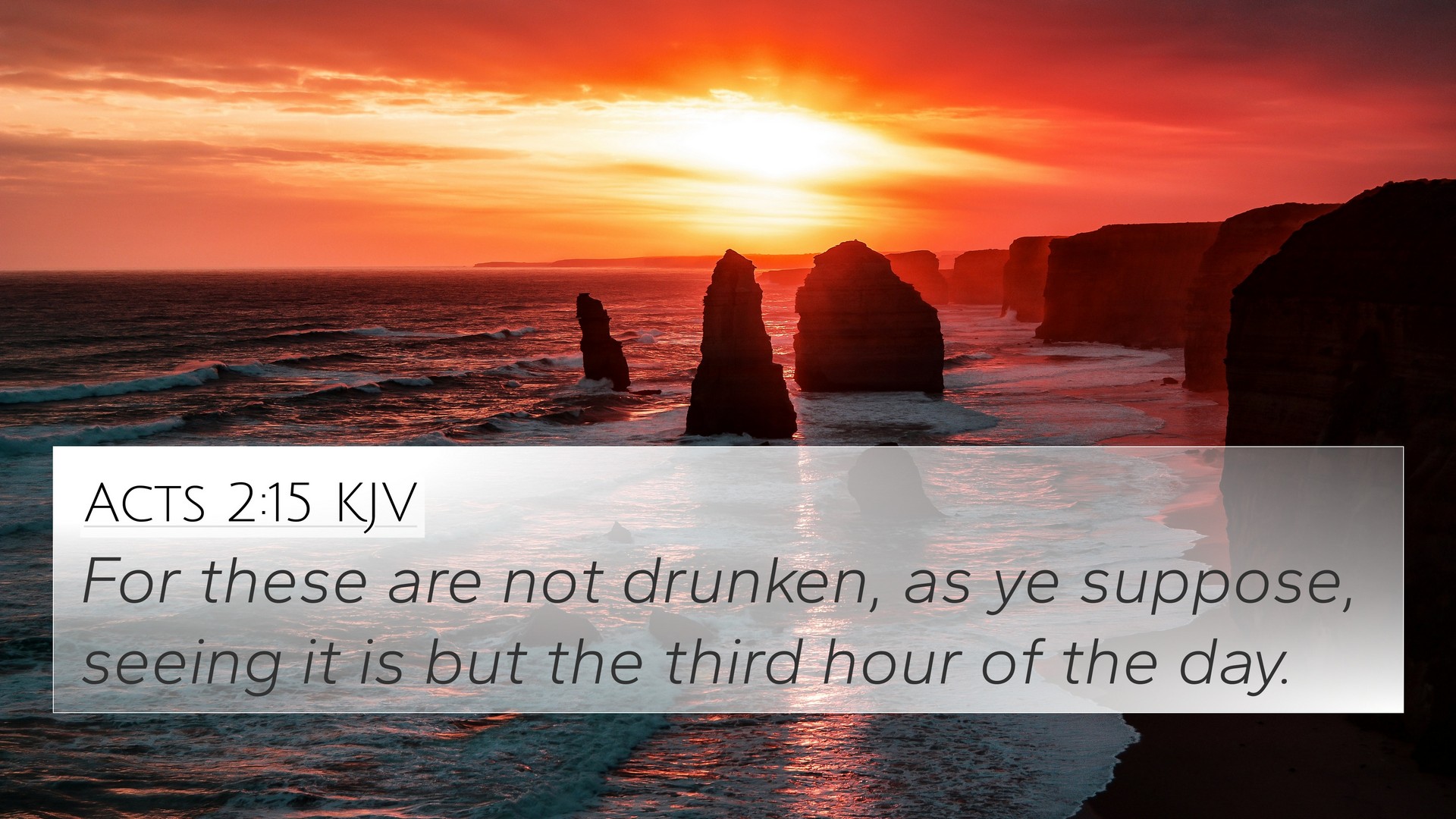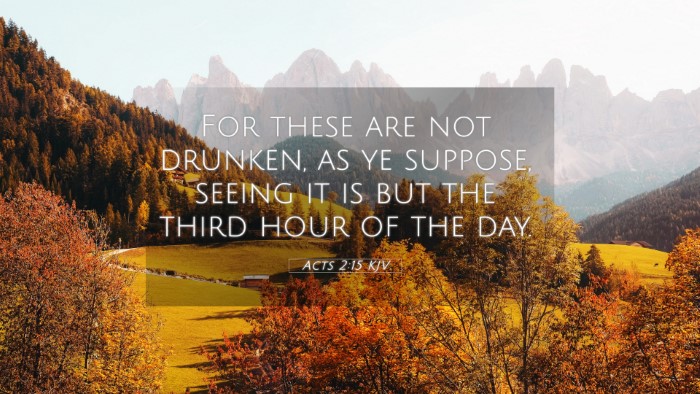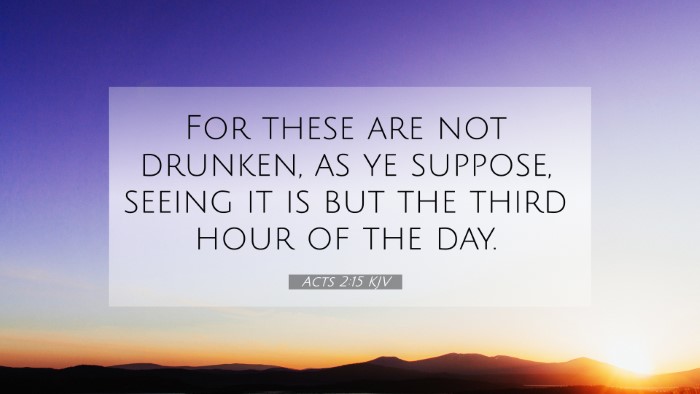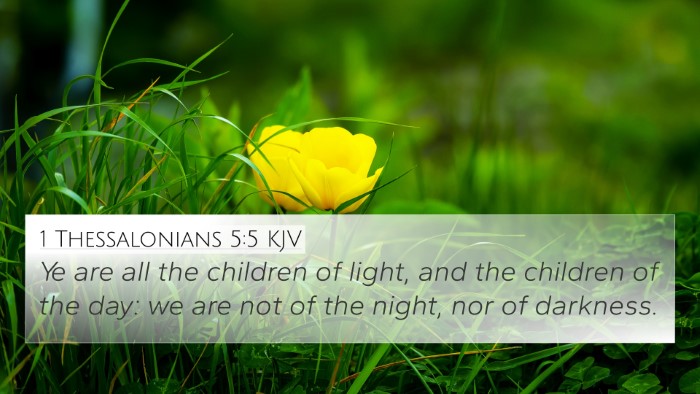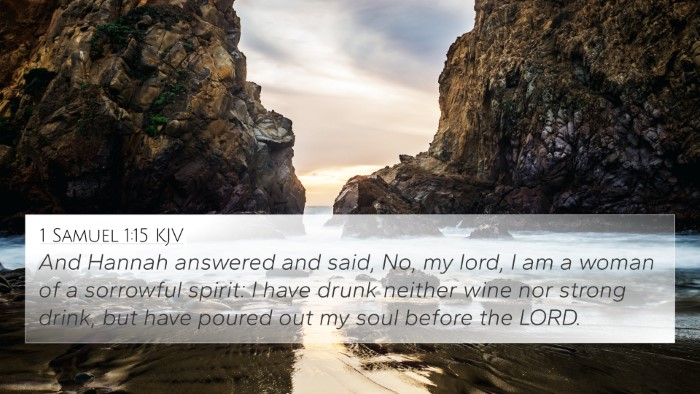Understanding Acts 2:15
The verse Acts 2:15 states, "For these are not drunken, as ye suppose, seeing it is but the third hour of the day." This statement was made by Peter during his address to the crowd witnessing the outpouring of the Holy Spirit at Pentecost. This verse provides clarity on the event that was unfolding, as many in the crowd mistakenly believed that the disciples were intoxicated.
Summary of Acts 2:15
In this context, Peter seeks to correct the misconception of the onlookers. The significance of the hour mentioned, the third hour (around 9 AM), is pivotal in reinforcing Peter's argument. He emphasizes that it is highly unlikely for anyone to be drunk at such an early hour. This moment marks a critical transition from public misunderstanding to a divine revelation of truth.
Contextual Background
The events occurring in Acts 2 are part of a broader narrative regarding the establishment of the Church and the fulfillment of Jesus' promise of the Holy Spirit (John 14:16-17). Pentecost, a Jewish festival occurring fifty days after Passover, becomes the backdrop for the Holy Spirit's descent, empowering the disciples to speak in different tongues.
Insights from Commentaries
- Matthew Henry: Henry emphasizes the importance of Peter's declaration in identifying the work of the Holy Spirit. He states that rather than being evidence of drunkenness, the tongues spoken were manifestations of divine activity.
- Albert Barnes: Barnes elaborates on the time reference, positing that it serves as an argument against the claims of inebriation. He provides a cultural understanding of drinking practices during that time to further substantiate Peter's argument.
- Adam Clarke: Clarke highlights that this assertion by Peter serves as a pivotal moment for the early Church, distinguishing spiritual phenomena from worldly interpretations. He posits that the early hour chosen for the event stands as a symbol of divine purpose and understanding.
Connections Between Bible Verses
Understanding Acts 2:15 invites a closer look at several related scripture passages:
- Joel 2:28-32: This passage predicts the outpouring of the Spirit, which Peter refers to in his sermon, establishing a prophetic link to the events at Pentecost.
- John 14:17: Here, Jesus promises the Holy Spirit to His followers, providing the foundation for the power Peter speaks of during this moment.
- Luke 24:49: Jesus instructs His disciples to wait for the promise of the Father, setting the stage for the events leading to Acts 2.
- Acts 2:4: This verse describes the moment the disciples were filled with the Holy Spirit, leading directly to the phenomenon Peter addresses.
- 1 Corinthians 14:23: Paul addresses the confusion that can arise among outsiders regarding speaking in tongues, echoing Peter's concerns about public perception.
- Proverbs 20:1: This verse cautions against the dangers of excessive drinking, affirming Peter’s assertion regarding the hour of the day.
- Acts 10:47-48: This account of the Holy Spirit falling upon Gentiles connects to the theme of God’s inclusive agenda in bestowing His Spirit, which Peter defends in Acts 2.
Thematic Bible Verse Connections
The verse serves to clarify themes of:
- Divine Guidance: The clear distinction between spiritual phenomena and human misconceptions emphasizes the need for discernment in spiritual matters.
- Empowerment for Ministry: Acts 2:15 is part of the larger narrative concerning the empowerment of believers for ministry through the Holy Spirit.
- Public Witness: This moment highlights the importance of public declaration and defense of the faith in the face of misunderstanding.
Practical Applications
Believers today can draw several practical applications from Acts 2:15:
- Understanding the significance of the Holy Spirit's work in our own lives and communities.
- Engaging with culture critically while maintaining a strong biblical perspective.
- Encouraging clarity in communication about the gospel to prevent misconceptions.
Conclusion
Acts 2:15 stands as a powerful reminder of divine work amidst misunderstanding. By exploring the context, insights from renowned commentaries, and thematic connections, we can gain a deeper understanding of this crucial moment in Church history. Embracing the teachings within offers a clearer path for sharing the gospel and engaging with misinterpretations in our current society.
